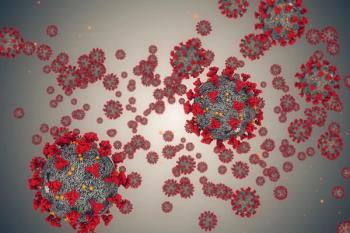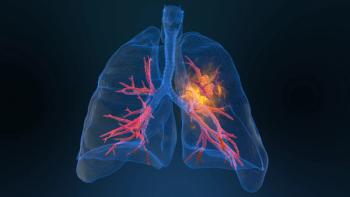
Wildfire Smoke Exposure in Infancy Linked to Earlier First Use of Respiratory Medicine
Researchers linked wildfire smoke exposure during early developmental periods to earlier first use of upper respiratory medications.
Researchers discovered earlier first use of
Wildfires have increased in frequency and severity over the past 2 decades, and particulate matter (PM) within wildfire smoke is associated with acute respiratory and other outcomes in exposed children. Despite other established effects, the researchers noted a lack of information on how wildfire smoke exposure affects infants.
“There is little known about the effects of in utero or in early life wildfire [PM] exposure on longer-term respiratory health outcomes,” the authors wrote. “Lung development continues through gestation into the postnatal period, a likely critical window of respiratory susceptibility to air pollution.”
Consequently, researchers investigated the association of smoke exposure during multiple developmental periods during gestation or infancy with the first use of respiratory medication. By doing so, they identified “critical windows of development where exposure to wildfire smoke may result in increased respiratory vulnerability in the population of young children.”
Researchers created their study population using prescription claims from IBM MarketScan Commercial Claims and Encounters database and linking them to wildfire smoke plume data from NASA satellites based on metropolitan statistical area (MSA). They examined a retrospective cohort of live infants born between 2010 and 2016 into MSAs in California, Oregon, Washington, Idaho, Montana, and Nevada. To be eligible for the study, infants also had to have continuous insurance enrollment with at least 1 week of prescription coverage starting at birth so that researchers could estimate their birthdate through claims data.
The researchers assessed a full cohort of 184,703 liveborn children and a subcohort of 113,154 liveborn children with gestational age (GA) estimates. Although the MarketScan data set does not contain explicit variables for GA at delivery, the researchers linked infant records to the birthing parent to determine GA.
To calculate participants’ average weekly smoke exposure days (smoke-days), researchers used their GAs, residential MSAs, and birthdates. Researchers defined smoke-days as “the appearance of a plume from satellite data, adjacent area” and examined their occurrences during the developmental periods of the 3 trimesters and 2 sequential 12-week postnatal periods.
“On average, children were exposed to less than 1 day of smoke per week in each exposure period; the mean trimester exposure ranged from 0.28 to 0.70 weekly smoke-days, and postnatal mean exposure ranged from 0.37 to 0.74, across the thresholds,” the authors wrote.
The researchers then classified medications treating respiratory tract inflammation into 3 categories based on active ingredients and modes of administration: upper respiratory, lower respiratory, and anti-inflammation. They used Cox models associating smoke-days with first medication use to evaluate associations between wildfire smoke exposure and medication usage, adjusting for infant sex, birth season, and birth year with a random intercept for MSA.
They found that smoke exposure during the first trimester and both postnatal periods was associated with shorter time to the first use of upper respiratory medication (HR per 1-day increase in weekly smoke-days, 1.094 [95% CI, 1.005-1.191] for postnatal period 1 and 1.108 [95% CI, 1.016-1.209] for postnatal period 2). This association was more prominent in female children exposed during the first trimester and first postnatal period but more prominent in male children exposed during the second postnatal period.
They also observed delayed first use of lower respiratory medication among children exposed during the first trimester (HR, 0.977 [95% CI, 0.951-1.003]) and longer time to first anti-inflammatory medication use in children in the GA subcohort exposed during the first and second trimesters (HR, 0.962 [95% CI, 0.927-0.997] in the first trimester and 0.946 [95% CI, 0.905-0.989] in the second trimester).
The researchers recognized several limitations to their study, the first being that the database omitted those with public insurance or living in a rural area; this could make the results less generalizable to these groups. Additionally, the database does not account for individual factors like race, socioeconomic status, and maternal or secondhand smoking.
Other limitations include assuming the same proportion of outdoor air pollution exposure among all participants, “which may contribute to the potential of exposure bias differential on socioeconomic status or other related factors.” Lastly, the researchers noted that some respiratory outcomes may be lost within claims data, which can only provide information on conditions treated by prescriptions for those who can access care.
Because of the impact of wildfire smoke exposure on pediatric populations, the researchers suggested measures parents may take to reduce its impact, like “discussing the potential benefits of reducing exposure using evidence-based measures such as observing air quality index alerts, placing air purifiers in their home, and wearing face masks to reduce particulate exposures.”
Although the researchers conducted the “first analysis describing the impact of exposure to wildfire smoke during development on prescription-treated respiratory conditions in human children,” they noted that future work is required to build on their findings.
“Future work should investigate specific clinical outcomes, such as acute respiratory infection, and utilize finer spatial and temporal granularity to refine estimates of wildfire smoke exposure,” the authors concluded. “This work also highlights the continued need to evaluate measures to protect against wildfire smoke during key developmental stages.”
Reference
Dhingra R, Keeler C, Staley BS, et al. Wildfire smoke exposure and early childhood respiratory health: a study of prescription claims data. Environ Health. 2023;22(48). doi:10.1186/s12940-023-00998-5
Newsletter
Stay ahead of policy, cost, and value—subscribe to AJMC for expert insights at the intersection of clinical care and health economics.















































